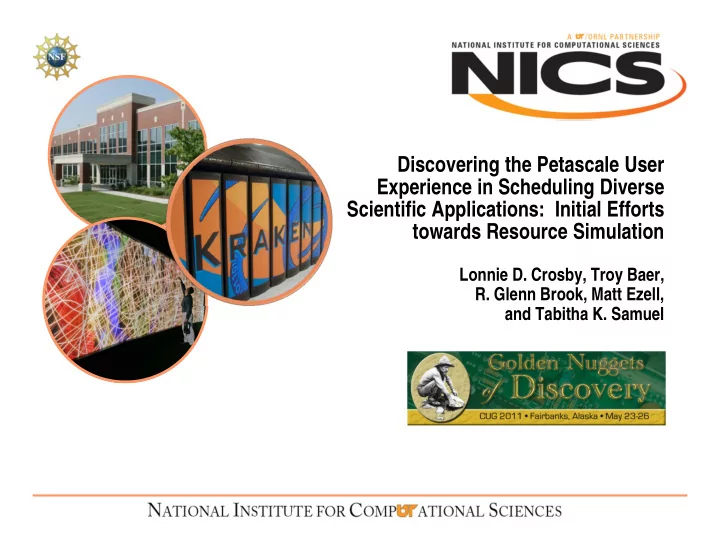

Discovering the Petascale User Experience in Scheduling Diverse Scientific Applications: Initial Efforts towards Resource Simulation Lonnie D. Crosby, Troy Baer, R. Glenn Brook, Matt Ezell, and Tabitha K. Samuel
Kraken (Cray XT5) Contains 9,408 compute nodes (112,896 cores) – each containing dual 2.6 GHz hex-core AMD “Istanbul” processors, 16 GB RAM, and a SeaStar 2+ interconnect. Peak Performance of 1.17 PF Scheduling Environment – TORQUE 2.4.8 – Moab 5.4.3 CUG 2011 2 “Golden Nuggets of Discovery”
Resource Scheduling Objectives Efficiently produce scientific results by maintaining high resource utilization (< 90%). providing reasonable throughput for all job classes. How do scheduling policies affect resource utilization? user experience in terms of job throughput? CUG 2011 3 “Golden Nuggets of Discovery”
Data Collection: Utilization Utilization – Snapshot based method System utilization is collected at regular intervals. – Collection of job statistics Utilization is calculated over periods based on job statistics. CUG 2011 4 “Golden Nuggets of Discovery”
Data Collection: Job Statistics Database solution – Collects information from the Moab event logs for each job. Metrics – Resource Utilization need resource downtime information to correct result. – Job distributions node count requested/used walltime queue duration CUG 2011 5 “Golden Nuggets of Discovery”
Resource Simulation Moab Simulation Mode – Resource Trace – Workload Trace – Configuration Resource Trace – The list of all compute nodes. No node failures included. Workload Trace – from period May 1 – December 31, 2010. (99,072 cores) – Various job types were removed. Configuration – Modified policy set derived from production resource CUG 2011 6 “Golden Nuggets of Discovery”
Policy Definition Production Resource Simulator Workload Trace Removed jobs – May 1 – Dec. 31, 2010 – > half resource – that don’t use compute nodes Resource Resource – Includes downtime and node failures – Constant 99,072 cores (8,256 – Preventative maintenance nodes) widows up to 8 hours. – Regular weekly PM window of 10 minutes. Policy Policy – Priority based primarily on core count. – User or project specific/temporal – Backfill enabled restrictions removed. – Reservation depth of one – Queue Depth of 1,000 – Limits on the number of eligible jobs per user (5) and project (10). CUG 2011 7 “Golden Nuggets of Discovery”
Resource Simulation Requirements Timeframe – Acquire job statistics over long time periods (6 months – 1yr) – Perform simulation in accelerated time (30 x) Reliable results – at least qualitative statistics with correct sign – at least qualitatively realistic behavior Goals – Experiment with policy changes – Determine the effect of changes on utilization and throughput CUG 2011 8 “Golden Nuggets of Discovery”
Simulation Experiment Jobs submitted on the production resource which do not have computational time remaining are given a quality of service (QoS) of negbal. This QoS receives a highly negative priority which makes the jobs the last to run. However, these jobs are eligible for backfill. Would disallowing these jobs from utilizing backfill adversely affect utilization or job throughput? CUG 2011 9 “Golden Nuggets of Discovery”
Some initial problems Classes of jobs remain in queue indefinitely – JOBCANCEL events – Jobs which are classified as Blocked by active policies Eventually starves the simulation of workload – May 1 – July 31, 2010 Simulation Time step – Poll Interval – changed from 30 – 60s to 5 – 10 minutes. CUG 2011 10 “Golden Nuggets of Discovery”
Utilization Results Average Utilization Baseline: 95% No Negbal: 84% CUG 2011 11 “Golden Nuggets of Discovery”
Utilization Results CUG 2011 12 “Golden Nuggets of Discovery”
Utilization Results CUG 2011 13 “Golden Nuggets of Discovery”
Some Conclusions Utilization drops drastically when “negbal” jobs are not allowed to backfill. Utilization drops seems to be partially due to less efficient draining profile. This profile seems to be due to a lack of jobs eligible for backfill. However, – Baseline: 11,774 “negbal” jobs were run (116,551 other jobs) – No negbal: 10,631 “negbal” jobs were run (99,091 other jobs) Jobs eligible for backfill seem to be plentiful – 55% of non-negbal jobs require less than 2 hours – 68% of non-negbal jobs require less than 512 compute cores CUG 2011 14 “Golden Nuggets of Discovery”
Effective Queue Duration CUG 2011 15 “Golden Nuggets of Discovery”
Effective Queue Duration CUG 2011 16 “Golden Nuggets of Discovery”
Probable Scenario Both experiments – Queue depth fills with immobile jobs, until no throughput possible No Negbal experiment – “Negbal” jobs also fill the queue depth, these are also largely immobile as long as other jobs are present. – When majority of queue depth (1,000) is composed of these jobs, any other available job get high effective priority. – When queue depth is filled with these jobs, they are run. However, backfill cannot be utilized. CUG 2011 17 “Golden Nuggets of Discovery”
Conclusion (Wish List) Fix simulation bugs – Remove problem of immobile jobs in queue. Simulation time step – Better control of simulation time step without a reliance on the Poll Interval. Queue formation – Utilize submission times present is workload trace. – Utilize a minimum queue depth to draw jobs in workload starvation situations. CUG 2011 18 “Golden Nuggets of Discovery”
Recommend
More recommend